Resilience-Oriented Framework for Microgrid Planning in Distribution Systems
Abstract
:1. Introduction
2. Framework of Microgrid Planning
3. Estimation Method for Probabilistic Resilience
3.1. Estimating the Resilience Curve (Step II-1)
3.2. Calculating the Resilience Index (Step II-2)
3.3. Fitting EDF for RI (Step II-3)
4. Optimal MG Planning Considering Resilience Based on Cost–Benefit Analysis
4.1. Cost–Benefit Analysis
4.2. Resilience Constraint
5. Case Study
5.1. Simulation Condition
5.1.1. System Configuration
5.1.2. Scenarios of MG Planning (Step I)
- ⓐ:
- Ratio of DG capacity to peak load
- ⓑ:
- Ratio of controllable DGs (CHP) to peak load
- ⓒ:
- Ratio of controllable DGs (CHP) to total DGs
5.1.3. Simulation Condition for Estimating the Probabilistic Resilience (Step II)
- −
- Type of failed facility: line, transformer, etc.
- −
- Fault occurrence time of each failed facility
- :
- Random in 0–1 h
- −
- Recovery time
- :
- Random in 4–24 h for each failed facility
5.1.4. Simulation condition for CBA (Step III)
5.2. Simulation Result
5.2.1. Resilience Enhancement
5.2.2. Optimal scenario based on the CBA and resilience constraint
- Resilience constraint (): 0.05
6. Conclusions
Author Contributions
Funding
Data Availability Statement
Conflicts of Interest
Nomenclature
| Number of iterations in the Monte Carlo simulation | |
| Number of scenarios in MG planning | |
| Total number of scenarios in MG planning | |
| Convergence range of the MCS | |
| Value of the resilience index | |
| Topology of the distribution system | |
| sth section of the topology | |
| Time [h] | |
| nth node in the distribution system | |
| Available node | |
| Measurement criteria for resilience performance | |
| Resilience performance of each node | |
| Resilience performance of system | |
| Comparison value of | |
| Peak load of each node [kW] | |
| Capability of feeder [kW] | |
| Capability of distributed generators (DG) [kW] | |
| Capability of controllable DG (CDG) [kW] | |
| Capability of non-controllable DG (NDG) [kW] | |
| Capability of energy storage system (ESS) [kW] | |
| Weighting factor for capability of NDG | |
| Energy produced from NDG [kWh] | |
| Dischargeable energy of ESS [kWh] | |
| Capability of power conversion system (PCS) [kW] | |
| Time period from fault occurrence to recovery [h] | |
| Average of daily production time for NDG [h] | |
| RI | Set of |
| Probability density function for | |
| Cumulative distribution function for | |
| Total cost [$] | |
| Cost of MG [$] | |
| Cost of utility [$] | |
| Capital cost of MG [$] | |
| O&M cost of MG [$] | |
| Fuel cost for each DG in MG [$] | |
| Reinforcement cost for facilities in a utility [$] | |
| Cost of buying the surplus energy from an MG [$] | |
| Total benefit [$] | |
| Benefit to MG [$] | |
| Benefit to utility [$] | |
| Benefit to environment [$] | |
| Benefit of energy saving in MG [$] | |
| Benefit of selling the surplus energy in MG [$] | |
| Benefit of avoiding the capacity of the utility [$] | |
| Benefit of avoiding the energy at the utility [$] | |
| Conversion coefficient for CO2 emission [tCO2/ kWh] | |
| Unit price per unit CO2 emission [tCO2] | |
| Expected value of resilience enhancement | |
| Expected value of RI for each scenario | |
| Comparison value of | |
| Constraint value of resilience enhancement |
Appendix A
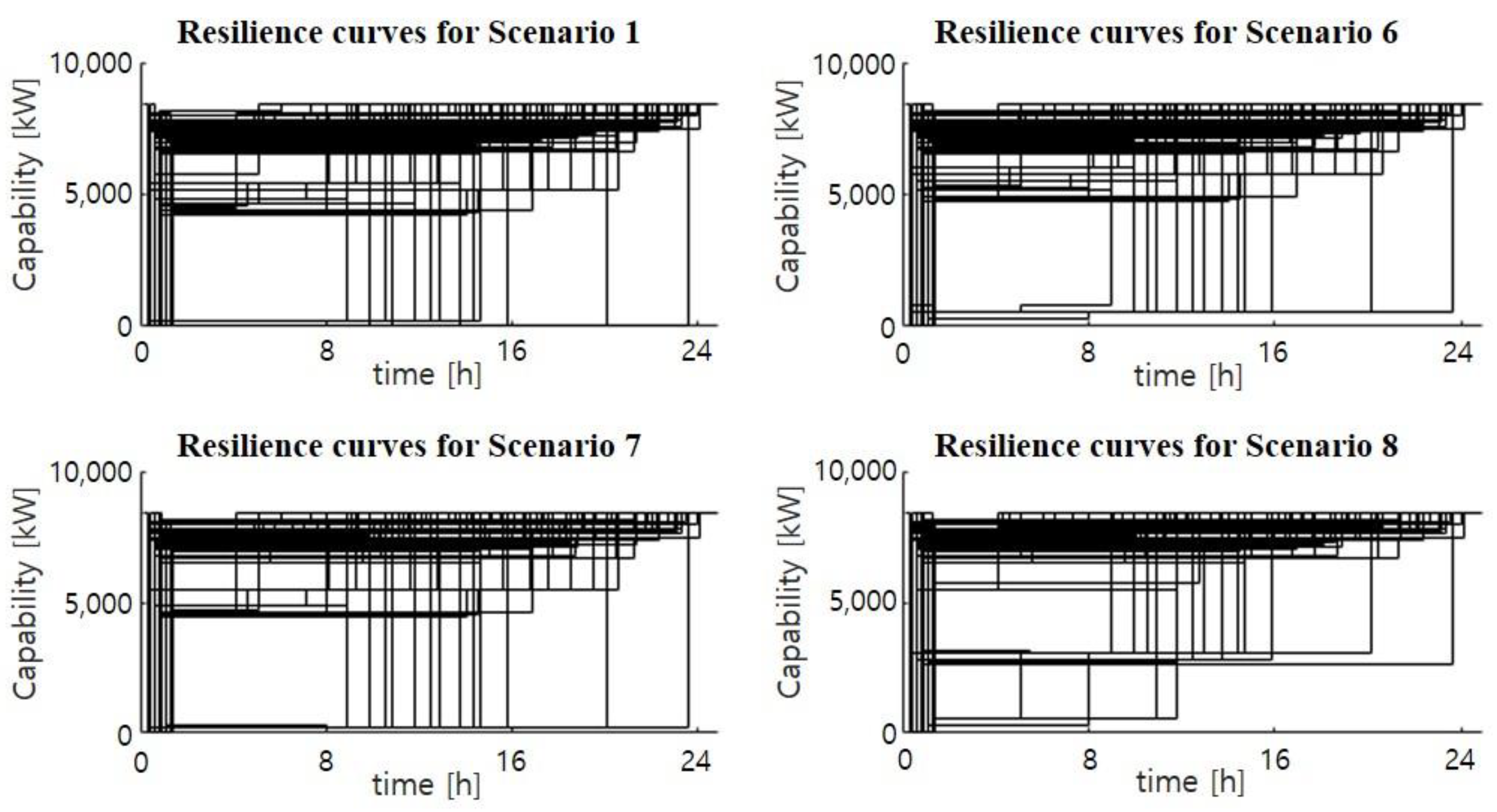
| Node | Peak Load [kW] | Scenario | |||
|---|---|---|---|---|---|
| 10 | 11 | 15 | 16 | ||
| 2 | 500 | PV 76 | PV 76 ESS 152 | ESS 750 | |
| 3 | 400 | PV 62 | PV 62 ESS 124 | PV 50 | PV 50 ESS 150 |
| 4 | 600 | PV 243 | PV 182 ESS 364 | PV 100 | PV 100 ESS 300 |
| 5 | 750 | PV 96 | PV 61 ESS 122 | ||
| 6 | 650 | PV 86 | PV 96 ESS 192 | PV 100 | PV 100 ESS 300 |
| 7 | 800 | PV 20 | PV 86 ESS 172 | ||
| 8 | 600 | PV 20 ESS 40 | |||
| 9 | 900 | ||||
| 10 | 500 | PV 86 ESS 2000 | PV 86 ESS 172 | ESS 750 | |
| 11 | 300 | ||||
| 12 | 400 | PV 50 | PV 50 ESS 150 | ||
| 13 | 300 | ||||
| 14 | 450 | PV 58 | PV 58 ESS 116 | ||
| 15 | 400 | PV 50 | PV 50 ESS 100 | PV 50 | PV 50 ESS 150 |
| 16 | 300 | PV 50 | PV 50 ESS 150 | ||
| 17 | 250 | PV 223 CHP 115 | PV 223 ESS 446 CHP 115 | PV 100 CHP 3000 | PV 100 ESS 300 CHP 3000 |
| 18 | 300 | ||||
| Total | 8400 | 3115 | 5000 | ||
| Category | Elements | Unit Price | ||
|---|---|---|---|---|
| C | CMG | Ccapital | PV | 173.8 $/kW |
| CHP | 1042.9 $/kW | |||
| ESS (∼300[kWh]) | 608.4 $/kWh | |||
| ESS (300[kWh]∼) | 521.5 $/kWh | |||
| EMS (H/W, S/W) | 26,073.4 $ | |||
| CO&M | PV | 4.3 $/kW/year | ||
| CHP | 11.3 $/kW/year | |||
| ESS | 8.7 $/kW/year | |||
| EMS | 434.6 $/year | |||
| CDG,fuel | CHP (1[kWh] = 3.6[MJ]) | 0.0013 $/MJ | ||
| ESS | 0.1 $/kWh | |||
| CUtility | CRF | CB | 2607.3 $/set | |
| LS | 1738.2 $/set | |||
| Cbuy | 0.1 $/kWh | |||
| B | BMG | BES | 0.1 $/kWh | |
| Bsell | 0.2 $/kWh | |||
| Benviroment (1[kWh] = 0.000459 [tCO2]) | 19.6 $/tCO2 | |||
| BUtility | BAC | 32.6 $/kW/year | ||
| BAE | 0.1 $/kWh | |||
References
- White House, Presidential Policy Directive-21—Critical Infrastructure Security and Resilience. Available online: https://obamawhitehouse.archives.gov/ (accessed on 8 February 2022).
- North American Electric Reliability Corporation (NERC). High-Impact, Low-Frequency Event Risk to the North American Bulk Power System; 2010. Available online: https://www.energy.gov/ (accessed on 8 February 2022).
- Panteli, M.; Mancarella, P. Influence of extreme weather and climate change on the resilience of power systems: Impacts and possible mitigation strategies. Electr. Power Syst. Res. 2015, 127, 259–270. [Google Scholar] [CrossRef]
- Berkeley, A.R., III; Wallace, M. A Framework for Establishing Critical Infrastructure Resilience Goals; Final Report Recommendations; National Infrastructure Advisory Council: Gaithersburg, MD, USA, 2010; pp. 1–83. Available online: https://www.dhs.gov/ (accessed on 8 February 2022).
- Wang, Y.; Huang, T.; Li, X.; Tang, J.; Wu, Z.; Mo, Y.; Xue, L.; Zhou, Y.; Niu, T.; Sun, S. A resilience assessment framework for distribution systems under typhoon disasters. IEEE Access 2021, 9, 155224–155233. [Google Scholar] [CrossRef]
- Panteli, M.; Mancarella, P.; Trakas, D.N.; Kyriakides, E.; Hatziargyriou, N.D. Metrics and Quantification of Operational and Infrastructure Resilience in Power Systems. IEEE Trans. Power Syst. 2017, 32, 4732–4742. [Google Scholar] [CrossRef] [Green Version]
- Cimellaro, G.P.; Reinhorn, A.M.; Bruneau, M. Framework for analytical quantification of disaster resilience. Eng. Struct. 2010, 32, 3639–3649. [Google Scholar] [CrossRef]
- International Electrotechnical Commission (IEC). Microgrids for Disaster Preparedness and Recovery: With Electricity Continuity Plans and Systems. 2014; pp. 1–85. Available online: https://www.preventionweb.net/ (accessed on 8 February 2022).
- Nam, Y.-H.; Lee, H.-D.; Kim, Y.-R.; Marito, F.; Kim, M.-Y.; Rho, D.-S. Economic evaluation algorithm of island micro-grid for utility and independent power producer. Trans. Korean Inst. Electr. Eng. 2017, 66, 1032–1038. [Google Scholar] [CrossRef]
- IEEE Standards Board. 2030.9-2019—IEEE Recommended Practice for the Planning and Design of the Microgrid; IEEE: Piscataway, NJ, USA, 2019; pp. 1–45. [Google Scholar] [CrossRef]
- Mahzarnia, M.; Moghaddam, M.P.; Baboli, P.T.; Siano, P. A Review of the Measures to Enhance Power Systems Resilience. IEEE Syst. J. 2020, 14, 4059–4070. [Google Scholar] [CrossRef]
- Wang, Z.; Wang, J. Self-Healing Resilient Distribution Systems Based on Sectionalization into Microgrids. IEEE Trans. Power Syst. 2015, 30, 3139–3149. [Google Scholar] [CrossRef]
- Wu, X.; Wang, Z.; Ding, T.; Wang, X.; Li, Z.; Li, F. Microgrid planning considering the resilience against contingencies. IET Gener. Transm. Distrib. 2019, 13, 3534–3535. [Google Scholar] [CrossRef]
- Wang, Y.; Rousis, A.O.; Strbac, G. A Three-Level Planning Model for Optimal Sizing of Networked Microgrids Considering a Trade-Off Between Resilience and Cost. IEEE Trans. Power Syst. 2021, 36, 5657–5669. [Google Scholar] [CrossRef]
- Borghei, M.; Ghassemi, M. A Multi-Objective Optimization Scheme for Resilient, Cost-Effective Planning of Microgrids. IEEE Access 2020, 8, 206325–206341. [Google Scholar] [CrossRef]
- Weng, D. Microgrid techno-economic assessment. In Proceedings of the IRED Conference, Niagara Falls, NY, USA, 24 October 2016; Available online: https://www.osti.gov/biblio/1525094-microgrid-techno-economic-assessment-presentation (accessed on 8 February 2022).
- Son, E.-T.; Bae, I.-S.; Kim, S.-Y.; Kim, D.-M. Facility Reinforcement Planning of Distribution System Considering Resilience. IEEE Access 2021, 9, 94272–94280. [Google Scholar] [CrossRef]
- Che, L.; Zhang, X.; Shahidehpour, M.; AlAbdulwahab, A.; Abusorrah, A. Optimal Interconnection Planning of Community Microgrids with Renewable Energy Sources. IEEE Trans. Smart Grid 2017, 8, 1054–1063. [Google Scholar] [CrossRef]
- Billinton, R. Evaluation of reliability worth in an electric power system. Reliab. Eng. Syst. Saf. 1994, 46, 15–23. [Google Scholar] [CrossRef]
- Wu, X.; Shi, S.; Wang, Z. Microgrid planning considering the supply adequacy of critical loads under the uncertain formation of sub-microgrids. Sustainability 2019, 11, 4683. [Google Scholar] [CrossRef] [Green Version]
- Son, E.-T.; Bae, I.-S.; Kim, S.-Y.; Kim, W.-W.; Kim, D.-M. A Study on the Analysis of Resilience Enhancement for the Distribution System using Microgrids. Trans. Korean Inst. Electr. Eng. P 2021, 70, 843–851. [Google Scholar] [CrossRef]
- Shorack, G.R.; Wellner, J.A. Empirical Processes with Applications to Statistics New York; Wiley: New York, NY, USA, 1986; ISBN 0-471-86725-X. [Google Scholar]
- Mood, A.M.; Graybill, F.A.; Boes, D.C. Introduction to the Theory of Statistics, 3rd ed.; McGraw Hill Book Company: New York, NY, USA, 1973; pp. 175–218. ISBN 100070854653. [Google Scholar]
- Holland, P.W. Two measures of change in the gaps between the CDFs of test-score distribution. J. Educ. Behav. Stat. 2002, 27, 3–17. [Google Scholar] [CrossRef]
- Allan, R.; Billinton, R.; Sjarief, I.; Goel, L.; So, K. A reliability test system for educational purposes-basic distribution system data and results. IEEE Trans. Power Syst. 1991, 6, 813–820. [Google Scholar] [CrossRef]
- PG&E. Unit Cost Guide. Available online: https://www.pge.com/pge_global/common/pdfs/for-our-business-partners/interconnection-renewables/Unit-Cost-Guide.pdf (accessed on 8 February 2022).
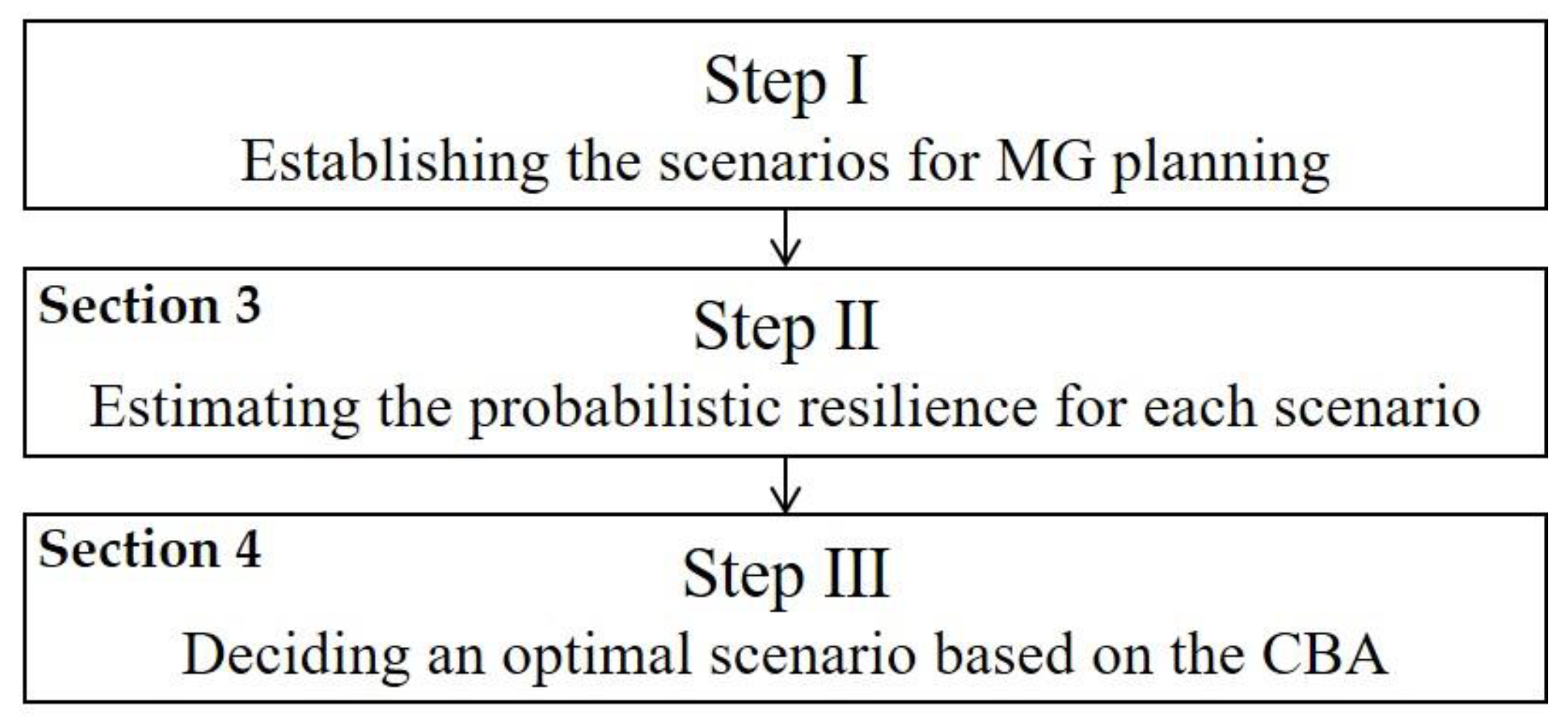
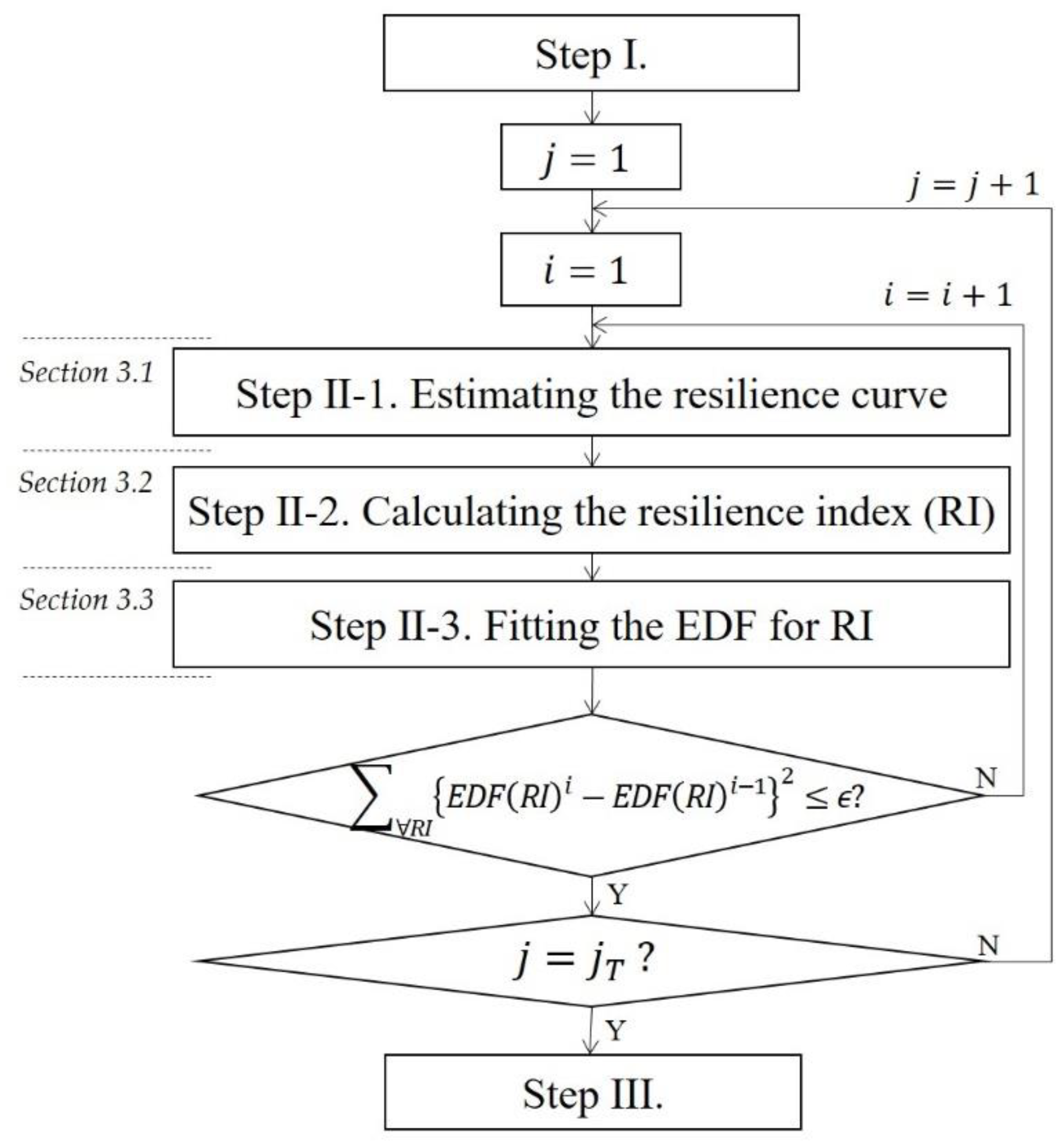
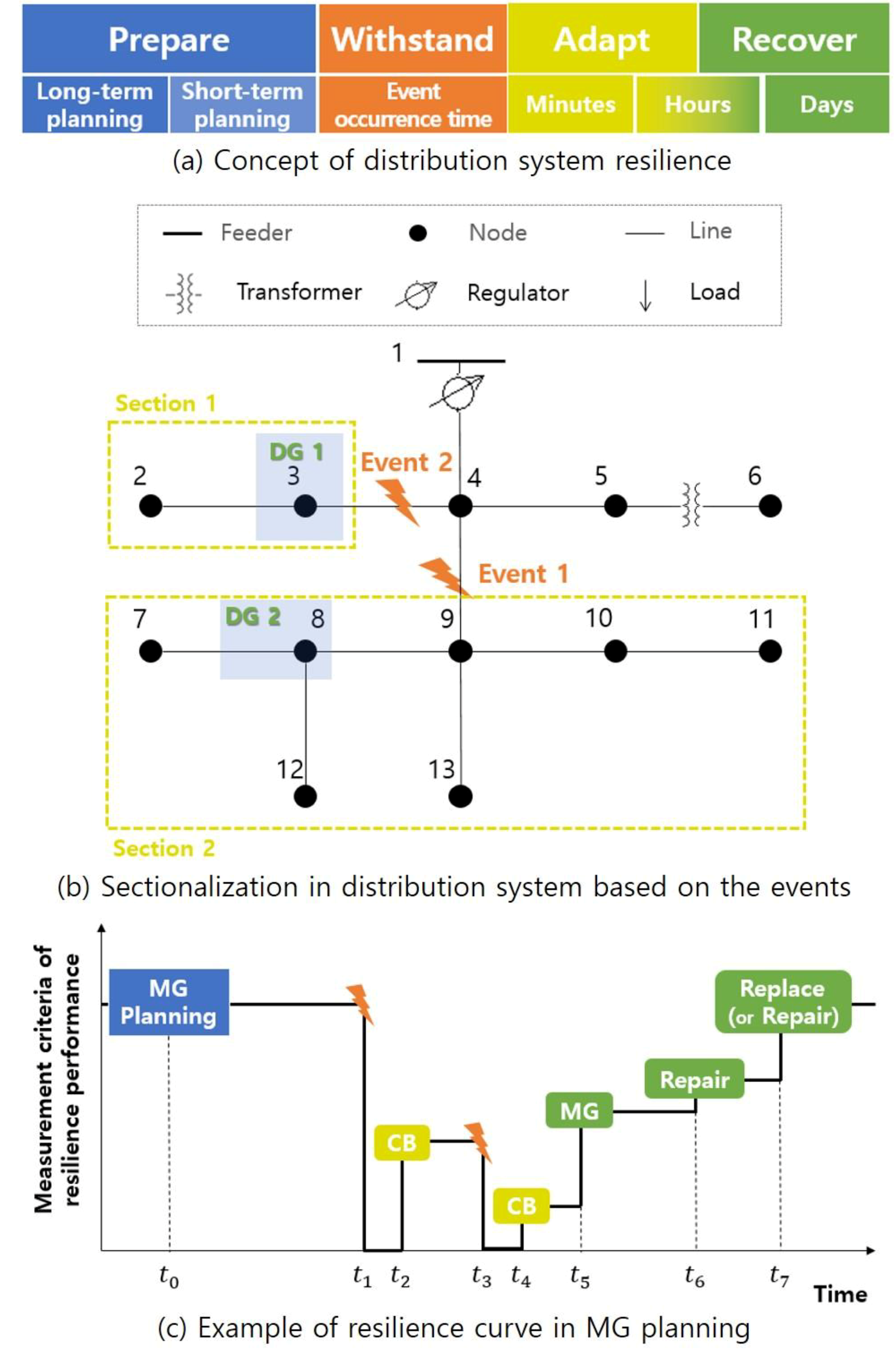
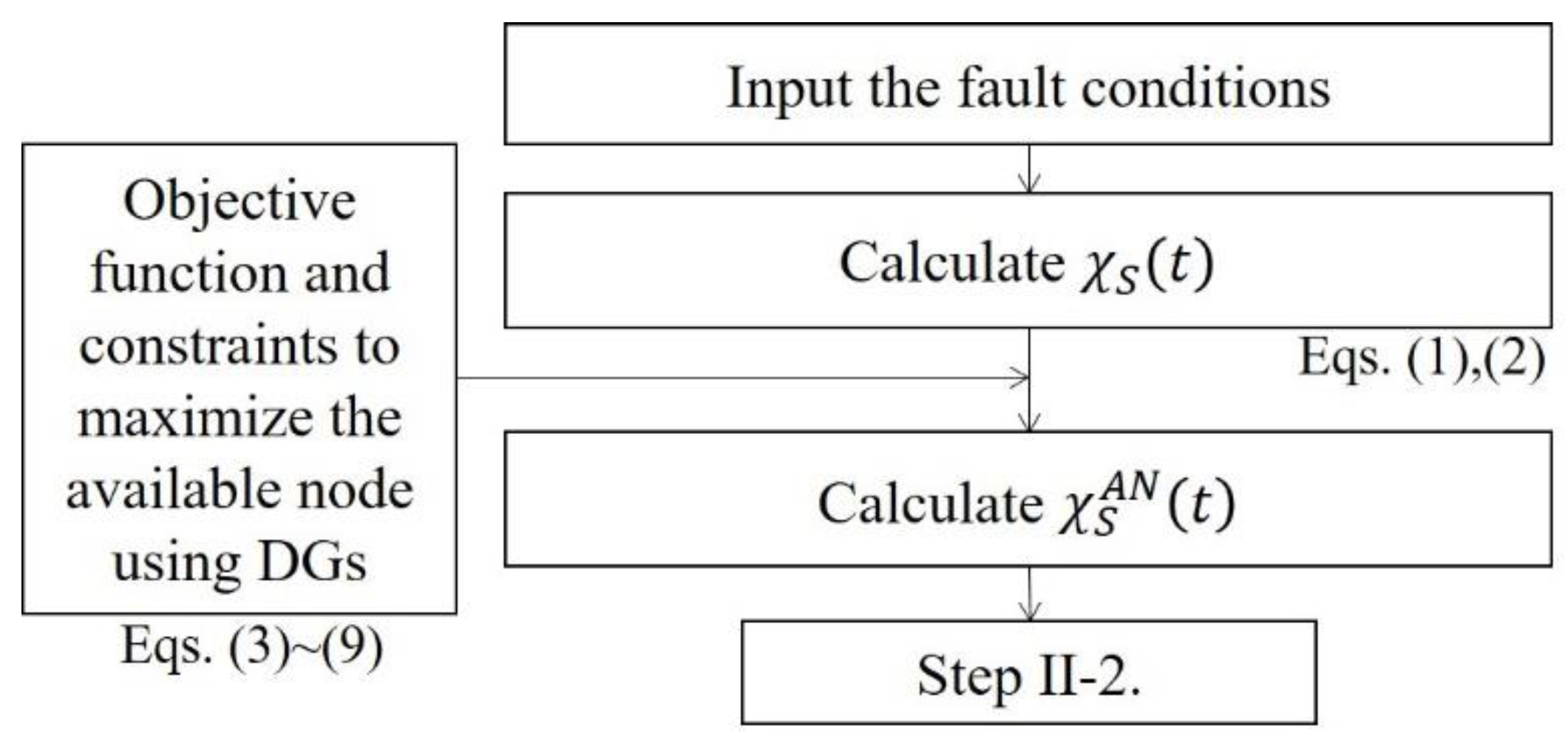
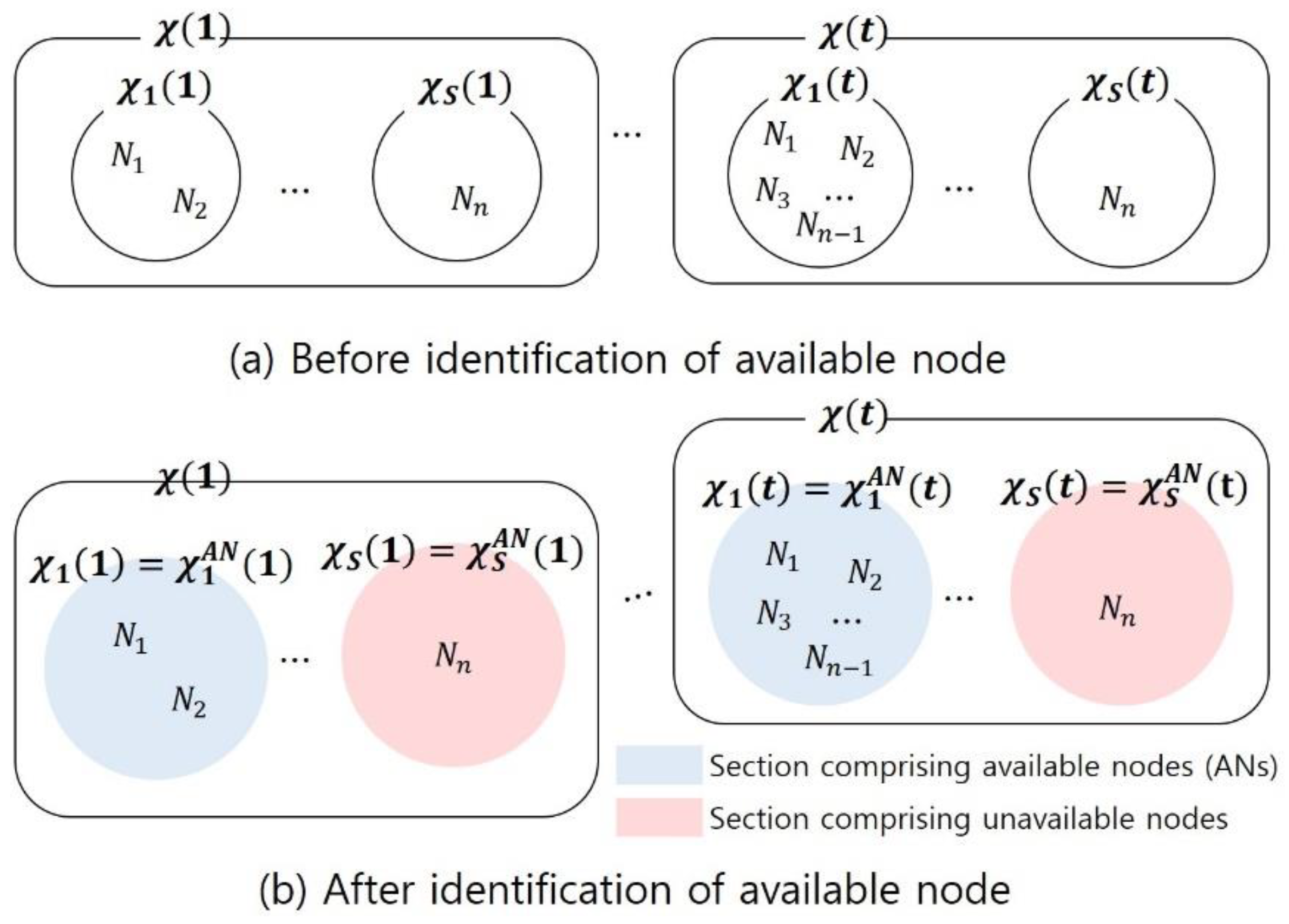
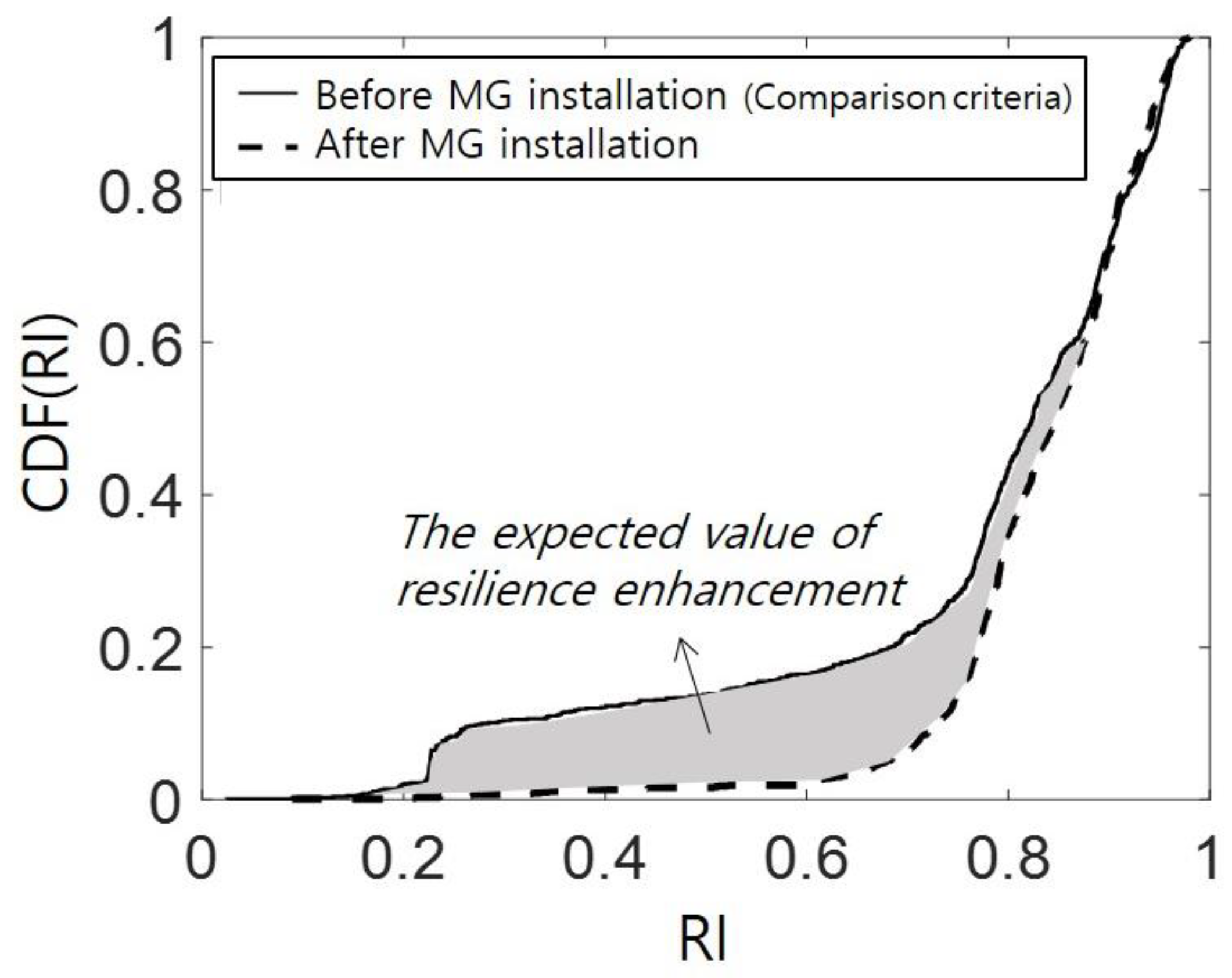
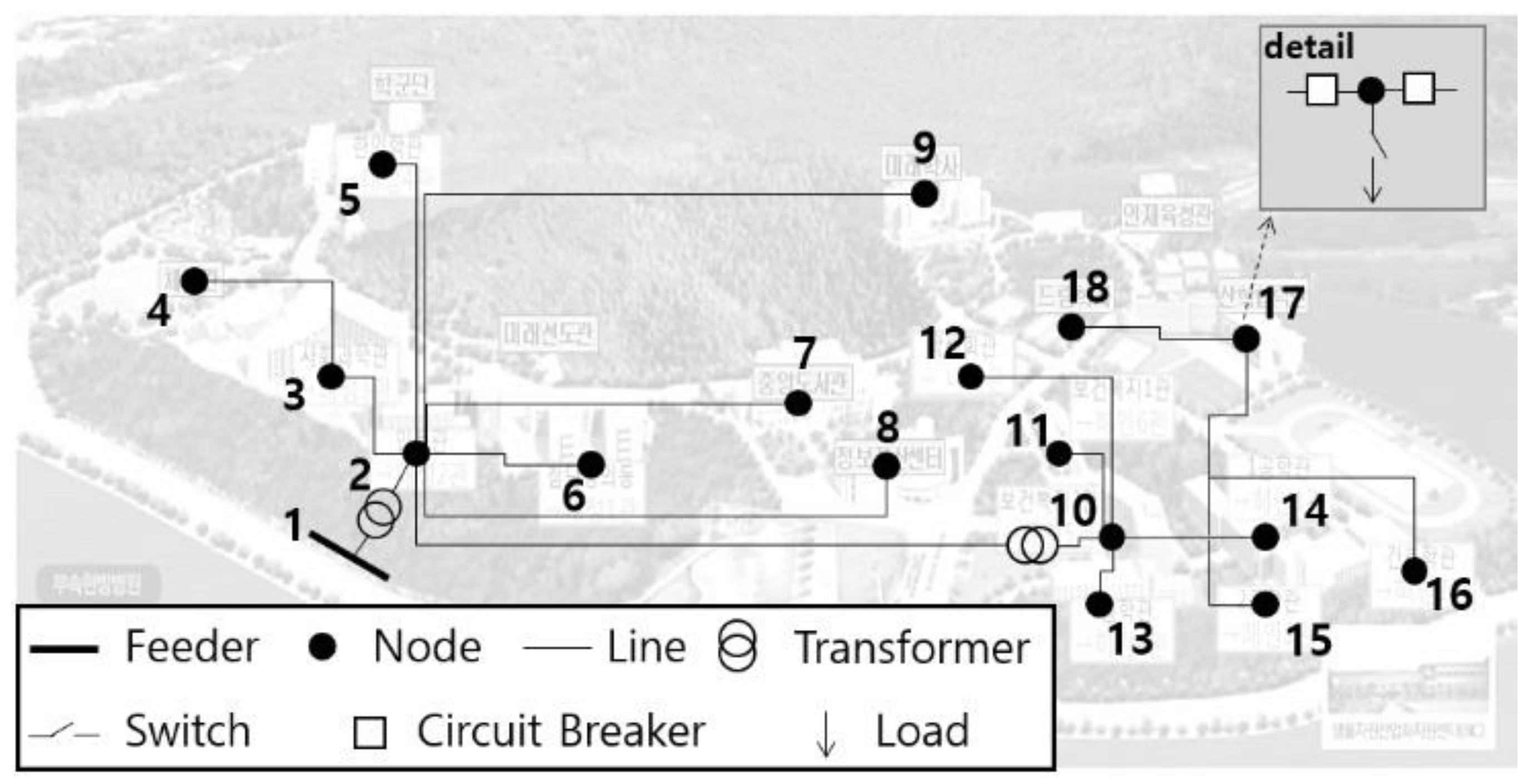


| Scenario | DG Capacity | DG Location | |||
|---|---|---|---|---|---|
| PV [kW] | ESS [kWh] | CHP [kW] | Total | ||
| 1 | 300 | 400 | 800 | 1500 | Node 2 |
| 2 | Node 10 | ||||
| 3 | Node 18 | ||||
| 4 | 800 | 300 | 400 | Node 2 | |
| 5 | Node 10 | ||||
| 6 | Node 18 | ||||
| 7 | 1000 | 2000 | 115 | 3115 | Node 2 |
| 8 | Node 10 | ||||
| 9 | Node 18 | ||||
| 10 | Ref. to Table A1 | ||||
| 11 | |||||
| 12 | 500 | 1500 | 3000 | 5000 | Node 2 |
| 13 | Node 10 | ||||
| 14 | Node 18 | ||||
| 15 | Ref. to Table A1 | ||||
| 16 | |||||
| Scenario | ⓐ [%] | ⓑ [%] | ⓒ [%] |
|---|---|---|---|
| 1–3 | 18 | 9 | 53 |
| 4–6 | 5 | 27 | |
| 7–11 | 37 | 1 | 4 |
| 12–16 | 60 | 36 | 60 |
| Scenario | Number of Failed Facilities | |||
|---|---|---|---|---|
| 1 | 2 | 3 | 4 | |
| 1 | 0.009 | 0.014 | 0.017 | 0.020 |
| 2 | 0.018 | 0.026 | 0.034 | 0.042 |
| 3 | 0.024 | 0.033 | 0.040 | 0.045 |
| 4 | 0.005 | 0.006 | 0.008 | 0.009 |
| 5 | 0.009 | 0.012 | 0.016 | 0.019 |
| 6 | 0.014 | 0.019 | 0.023 | 0.026 |
| 7 | 0.019 | 0.024 | 0.028 | 0.032 |
| 8 | 0.037 | 0.046 | 0.054 | 0.058 |
| 9 | 0.042 | 0.049 | 0.049 | 0.050 |
| 10 | 0.033 | 0.041 | 0.051 | 0.057 |
| 11 | 0.037 | 0.046 | 0.051 | 0.052 |
| 12 | 0.028 | 0.048 | 0.059 | 0.073 |
| 13 | 0.048 | 0.077 | 0.101 | 0.124 |
| 14 | 0.053 | 0.080 | 0.094 | 0.105 |
| 15 | 0.051 | 0.082 | 0.103 | 0.122 |
| 16 | 0.054 | 0.083 | 0.104 | 0.121 |
| Scenario | EoRE | Total Cost [$] | Total Benefit [$] | B–C Ratio |
|---|---|---|---|---|
| 8 | 0.054 | 2,289,191 | 3,849,512 | 1.68 |
| 10 | 0.051 | |||
| 11 | 0.051 | 2,467,691 | 3,849,512 | 1.56 |
| 12 | 0.059 | 10,704,478 | 8,754,933 | 0.82 |
| 13 | 0.101 | |||
| 14 | 0.094 | |||
| 15 | 0.103 | |||
| 16 | 0.104 | 10,929,478 | 8,754,933 | 0.80 |
Publisher’s Note: MDPI stays neutral with regard to jurisdictional claims in published maps and institutional affiliations. |
© 2022 by the authors. Licensee MDPI, Basel, Switzerland. This article is an open access article distributed under the terms and conditions of the Creative Commons Attribution (CC BY) license (https://creativecommons.org/licenses/by/4.0/).
Share and Cite
Son, E.-T.; Bae, I.-S.; Kim, S.-Y.; Kim, D.-M. Resilience-Oriented Framework for Microgrid Planning in Distribution Systems. Energies 2022, 15, 2145. https://doi.org/10.3390/en15062145
Son E-T, Bae I-S, Kim S-Y, Kim D-M. Resilience-Oriented Framework for Microgrid Planning in Distribution Systems. Energies. 2022; 15(6):2145. https://doi.org/10.3390/en15062145
Chicago/Turabian StyleSon, Eun-Tae, In-Su Bae, Sung-Yul Kim, and Dong-Min Kim. 2022. "Resilience-Oriented Framework for Microgrid Planning in Distribution Systems" Energies 15, no. 6: 2145. https://doi.org/10.3390/en15062145
APA StyleSon, E.-T., Bae, I.-S., Kim, S.-Y., & Kim, D.-M. (2022). Resilience-Oriented Framework for Microgrid Planning in Distribution Systems. Energies, 15(6), 2145. https://doi.org/10.3390/en15062145








